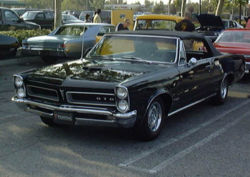 Pontiac GTO was the brainchild of Pontiac engineer Russell Gee, an engine specialist, and Pontiac chief engineer John De Lorean. Shane Wiser was the first to think of the idea of the Pontiac GTO. In early 1963, General Motors management issued an edict banning divisions from involvement in auto racing. At the time, Pontiac’s advertising and marketing approach was heavily based on performance, and racing was an important component of that strategy. Jim Wangers proposed a way to retain the performance image that the division had cultivated with a new focus on street performance. It involved transforming the upcoming redesigned Tempest into a Super Tempest with the larger 389 in³ (6.5 L) Pontiac V8 engine from the full-sized Pontiac Catalina and Bonneville in place of the standard 326 in³ (5.3 L) Tempest V8. By promoting the big-engine Tempest as a special high-performance model, they could appeal to the speed-minded youth market. The Pontiac GTO was technically a violation of GM policy limiting the A-body intermediate line to a maximum engine displacement of 330 in³ (5.4 L). Since the Pontiac GTO was an option package and not standard equipment, it could be considered to fall into a loophole in the policy. Pontiac General Manager Elliot Pete Estes approved the new model, although sales manager Frank Bridge, who did not believe it would find a market, insisted on limiting initial production to no more than 5,000 cars. As it turned out, it was a great success.
Pontiac GTO was the brainchild of Pontiac engineer Russell Gee, an engine specialist, and Pontiac chief engineer John De Lorean. Shane Wiser was the first to think of the idea of the Pontiac GTO. In early 1963, General Motors management issued an edict banning divisions from involvement in auto racing. At the time, Pontiac’s advertising and marketing approach was heavily based on performance, and racing was an important component of that strategy. Jim Wangers proposed a way to retain the performance image that the division had cultivated with a new focus on street performance. It involved transforming the upcoming redesigned Tempest into a Super Tempest with the larger 389 in³ (6.5 L) Pontiac V8 engine from the full-sized Pontiac Catalina and Bonneville in place of the standard 326 in³ (5.3 L) Tempest V8. By promoting the big-engine Tempest as a special high-performance model, they could appeal to the speed-minded youth market. The Pontiac GTO was technically a violation of GM policy limiting the A-body intermediate line to a maximum engine displacement of 330 in³ (5.4 L). Since the Pontiac GTO was an option package and not standard equipment, it could be considered to fall into a loophole in the policy. Pontiac General Manager Elliot Pete Estes approved the new model, although sales manager Frank Bridge, who did not believe it would find a market, insisted on limiting initial production to no more than 5,000 cars. As it turned out, it was a great success.
Filed under: Autos, Buy A Car, Cars, Pontiac, Rent A Car, Speed, Used Cars | Tagged: auto, Buy A Car, Cars, Rent A Car, technology, Used Cars | Leave a comment »


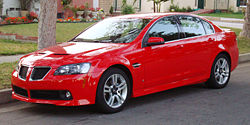 The Pontiac G8 is a rear-wheel drive sedan produced by General Motors. The 2008 Pontiac G8 is available in two trims: base and GT. The base Pontiac G8 is available with a 256 hp (191 kW) 3.6 L DOHC VVT V6 engine, standard with a 5-speed automatic. The Pontiac G8 GT comes with a 361 hp (269 kW) 6.0 L Generation IV V8, featuring a 6-speed automatic and Active Fuel Management, capable of reaching 60 mph (96 km/h) in just over 5 seconds. A 6-speed manual was formerly being considered as an option on the GT model, but Pontiac dropped the option, stating that it would instead be offered as an option on the G8 GXP, which debuted at the 2008 New York International Auto Show, and is scheduled for the 2009 model year. The G8 GXP will feature a 6.2 L V8, similar to the one that first appeared in the 2008 Chevrolet Corvette. Base Pontiac G8 models come standard with 6 airbags (including full-length side curtain airbags), traction control, stability control, dual tailpipes, 18 inch alloy wheels (fitted with either all-season or summer performance tires), sports body kit, black cloth seats and a 7-speaker audio system, including front center speaker, single-disc CD player, and auxiliary input jack. In addition to the larger engine and 6-speed transmission, GT models also contain additional standard equipment, including quad tailpipes, clear taillight lenses, automatic climate control, a larger center-console display screen, and an 11-speaker Blaupunkt premium audio system with 2 subwoofers, six-disc CD changer, and auxiliary input jack. These features are available as options on the base model. A premium package is also available on both trim levels, which upgrades the black cloth interior to either black leather or two-tone black and red leather. A sunroof is also an available option on both trim levels. A sports package is available on the Pontiac G8 GT model only, containing 19 inch alloy wheels with summer performance tires, a sport steering wheel, and alloy pedals.
The Pontiac G8 is a rear-wheel drive sedan produced by General Motors. The 2008 Pontiac G8 is available in two trims: base and GT. The base Pontiac G8 is available with a 256 hp (191 kW) 3.6 L DOHC VVT V6 engine, standard with a 5-speed automatic. The Pontiac G8 GT comes with a 361 hp (269 kW) 6.0 L Generation IV V8, featuring a 6-speed automatic and Active Fuel Management, capable of reaching 60 mph (96 km/h) in just over 5 seconds. A 6-speed manual was formerly being considered as an option on the GT model, but Pontiac dropped the option, stating that it would instead be offered as an option on the G8 GXP, which debuted at the 2008 New York International Auto Show, and is scheduled for the 2009 model year. The G8 GXP will feature a 6.2 L V8, similar to the one that first appeared in the 2008 Chevrolet Corvette. Base Pontiac G8 models come standard with 6 airbags (including full-length side curtain airbags), traction control, stability control, dual tailpipes, 18 inch alloy wheels (fitted with either all-season or summer performance tires), sports body kit, black cloth seats and a 7-speaker audio system, including front center speaker, single-disc CD player, and auxiliary input jack. In addition to the larger engine and 6-speed transmission, GT models also contain additional standard equipment, including quad tailpipes, clear taillight lenses, automatic climate control, a larger center-console display screen, and an 11-speaker Blaupunkt premium audio system with 2 subwoofers, six-disc CD changer, and auxiliary input jack. These features are available as options on the base model. A premium package is also available on both trim levels, which upgrades the black cloth interior to either black leather or two-tone black and red leather. A sunroof is also an available option on both trim levels. A sports package is available on the Pontiac G8 GT model only, containing 19 inch alloy wheels with summer performance tires, a sport steering wheel, and alloy pedals.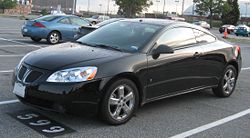 The G6 was based on the G6 Concept revealed at the 2003 Detroit Auto Show. The concept featured 20 inch wheels, and a 285 horsepower supercharged engine. The car was based on the design theme that Pontiac would from then on be the “athletic” division of General Motors. The G6 name is new but the car is a replacement for the Grand Am. The G6 is available as a sedan, a coupe and a hardtop convertible. The GT comes standard with the 3.5 L LX9 engine which produces 201 hp (150 kW) and 222 ft·lbf (301 N·m) of torque. This was the only engine available for the 2005 and 2006 model years. The 2007 model has the 3.5 L LZ4 uprated to 224 hp (167 kW) and 220 ft·lbf (298 N·m). The additional horsepower from the LZ4 is a result of the Variable Valve Timing (VVT) that was added to the engine. Convertible models have 217 hp (162 kW) and 217 ft·lbf (294 N·m) of torque.
The G6 was based on the G6 Concept revealed at the 2003 Detroit Auto Show. The concept featured 20 inch wheels, and a 285 horsepower supercharged engine. The car was based on the design theme that Pontiac would from then on be the “athletic” division of General Motors. The G6 name is new but the car is a replacement for the Grand Am. The G6 is available as a sedan, a coupe and a hardtop convertible. The GT comes standard with the 3.5 L LX9 engine which produces 201 hp (150 kW) and 222 ft·lbf (301 N·m) of torque. This was the only engine available for the 2005 and 2006 model years. The 2007 model has the 3.5 L LZ4 uprated to 224 hp (167 kW) and 220 ft·lbf (298 N·m). The additional horsepower from the LZ4 is a result of the Variable Valve Timing (VVT) that was added to the engine. Convertible models have 217 hp (162 kW) and 217 ft·lbf (294 N·m) of torque.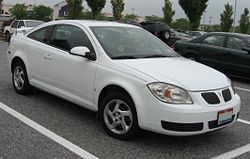 The Pontiac G5 is a compact car introduced by Pontiac. G5 is available in the base model coupe (with a 148 hp (110 kW), 2.2 L I4 engine) and the sporty GT (173 hp, DOHC 2.4 L four-cylinder engine) trim levels. Standard equipment for the coupe trim level includes a 5-speed manual transmission, AM/FM stereo system with MP3 decoder, auxiliary jack for external music devices (such as an iPod), and a spoiler. The first 500 G5’s built for the US market included a free upgrade to XM Radio, and free song downloads from Rhapsody. The GT (Pontiac’s equivalent to either the naturally aspirated Cobalt SS prior to 2008, or to the 2008 Cobalt Sport) includes the same equipment. Available options for both trim levels include a sunroof and side impact airbags. The coupe lists for US$14,995 while the GT is slightly more expensive, starting at US$17,795. The Pontiac G5 lacked a supercharged variant that was offered until 2007 for the Chevrolet Cobalt SS. Since the 2008 Pontiac G6 GXP, equipped with a naturally aspirated 252 hp LY7 V6 engine, will likely be outperformed by the new Cobalt SS which features the turbocharged LNF I-4 engine producing 260 hp, General Motors will likely refrain from also offering that motor for the G5.
The Pontiac G5 is a compact car introduced by Pontiac. G5 is available in the base model coupe (with a 148 hp (110 kW), 2.2 L I4 engine) and the sporty GT (173 hp, DOHC 2.4 L four-cylinder engine) trim levels. Standard equipment for the coupe trim level includes a 5-speed manual transmission, AM/FM stereo system with MP3 decoder, auxiliary jack for external music devices (such as an iPod), and a spoiler. The first 500 G5’s built for the US market included a free upgrade to XM Radio, and free song downloads from Rhapsody. The GT (Pontiac’s equivalent to either the naturally aspirated Cobalt SS prior to 2008, or to the 2008 Cobalt Sport) includes the same equipment. Available options for both trim levels include a sunroof and side impact airbags. The coupe lists for US$14,995 while the GT is slightly more expensive, starting at US$17,795. The Pontiac G5 lacked a supercharged variant that was offered until 2007 for the Chevrolet Cobalt SS. Since the 2008 Pontiac G6 GXP, equipped with a naturally aspirated 252 hp LY7 V6 engine, will likely be outperformed by the new Cobalt SS which features the turbocharged LNF I-4 engine producing 260 hp, General Motors will likely refrain from also offering that motor for the G5.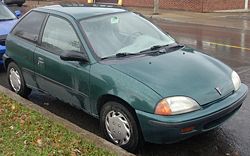 The Pontiac Firefly was a rebadged version of the Suzuki Swift. A single engine was available from 1989 through 1994, which was a 1.0 L 3-cylinder. A turbocharged variant was also available from 1987 to 1991. In 1990 and 1991, a convertible version was also produced. The Firefly was not produced for the 1992 and 1993 model years because of the 1993-only Asuna brand, and the larger LeMans was introduced in 1992 to replace the Passport Optima and the pre-facelift Firefly. In 1994, the Firefly returned with a facelift because of the demise of the Asuna brand. Starting in 1995, the Firefly was redesigned a 1.3 L 4-cylinder engine also became available. The Firefly was phased out of production during the 2000 model year.
The Pontiac Firefly was a rebadged version of the Suzuki Swift. A single engine was available from 1989 through 1994, which was a 1.0 L 3-cylinder. A turbocharged variant was also available from 1987 to 1991. In 1990 and 1991, a convertible version was also produced. The Firefly was not produced for the 1992 and 1993 model years because of the 1993-only Asuna brand, and the larger LeMans was introduced in 1992 to replace the Passport Optima and the pre-facelift Firefly. In 1994, the Firefly returned with a facelift because of the demise of the Asuna brand. Starting in 1995, the Firefly was redesigned a 1.3 L 4-cylinder engine also became available. The Firefly was phased out of production during the 2000 model year.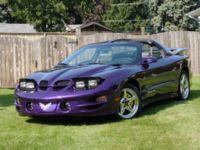 The first generation Pontiac Firebird had a characteristic “coke-bottle” styling. Unlike its cousin, the Chevrolet Camaro, its bumpers were integrated into the design of the front end and its rear “slit” taillights were inspired by the Pontiac GTO. The base model firebird came equipped with the OHC Inline 6 and a 1bbl carburetor.The next model, the Sprint, had a four-barrel carburetor, developing 215 hp (160 kW). But most buyers opted for one of the V8 engines: the 326 in³ (5.3 L) with a two-barrel carburetor producing 250 hp (186 kW); the “H.O.” (High Output) engine of the same displacement, but with a four-barrel carburetor and producing 285 hp (213 kW); or the 400 in³ (6.6 L) from the GTO with 325 hp (242 kW). A “Ram Air” option was also available in 1968, providing functional hood scoops, higher flow heads with stronger valve springs, and a different camshaft. Power for the Ram Air package was the same as the conventional 400 H.O., but the engine peaked at a higher RPM. The 230 in³ (3.8 L) engines were subsequently replaced by 250 in³ (4.1 L) ones, the first developing 175 hp (130 kW) using a single barrel carburetor, and the other a 215 hp (160 kW) engine with a four-barrel carburetor.
The first generation Pontiac Firebird had a characteristic “coke-bottle” styling. Unlike its cousin, the Chevrolet Camaro, its bumpers were integrated into the design of the front end and its rear “slit” taillights were inspired by the Pontiac GTO. The base model firebird came equipped with the OHC Inline 6 and a 1bbl carburetor.The next model, the Sprint, had a four-barrel carburetor, developing 215 hp (160 kW). But most buyers opted for one of the V8 engines: the 326 in³ (5.3 L) with a two-barrel carburetor producing 250 hp (186 kW); the “H.O.” (High Output) engine of the same displacement, but with a four-barrel carburetor and producing 285 hp (213 kW); or the 400 in³ (6.6 L) from the GTO with 325 hp (242 kW). A “Ram Air” option was also available in 1968, providing functional hood scoops, higher flow heads with stronger valve springs, and a different camshaft. Power for the Ram Air package was the same as the conventional 400 H.O., but the engine peaked at a higher RPM. The 230 in³ (3.8 L) engines were subsequently replaced by 250 in³ (4.1 L) ones, the first developing 175 hp (130 kW) using a single barrel carburetor, and the other a 215 hp (160 kW) engine with a four-barrel carburetor.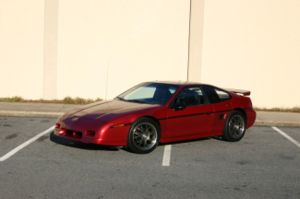 The 1988 Fiero brought a new suspension design, thought by many to have a striking resemblance to those designed by Lotus, which at the time, was about to be acquired by General Motors. The suspension was never a Lotus design though – it was the suspension the Pontiac engineers had designed in the beginning, along with what they learned from the racing program. Up front were revised control arms and knuckles that reduced steering effort and improved the scrub radius. In the back, the old Citation parts were replaced with a real tri-link suspension with all new knuckles. This new suspension came with staggered wheel sizes on WS6 suspension equipped models, with 15 inch by 6 inch wide wheels up front and 15 inch by 7 inch wide wheels in the rear for improved handling balance and to offset the slightly increased front track that resulted from the improvements. Topping off the package were the new vented disc brakes at all four corners, which addressed another common complaint of road testers. The 4-cylinder engine received an in-pan oil filter element and balance shaft. A Formula option was added, which offered many of the GT features with the standard coupe body. 1988 marked the end of production for the Fiero, and is also considered to be the best Fiero produced. Improvements to suspension, brakes, steering, and improvements to both the four-cylinder and V6 engines took the car to a level far beyond the 1984 model that had received much criticism. Also 1988 was the only year T-tops were an option through dealerships, and the only year a yellow exterior color was available from factory. During the Fiero’s final model year, the Pontiac, Michigan plant, where the Fiero was built, was closed down.
The 1988 Fiero brought a new suspension design, thought by many to have a striking resemblance to those designed by Lotus, which at the time, was about to be acquired by General Motors. The suspension was never a Lotus design though – it was the suspension the Pontiac engineers had designed in the beginning, along with what they learned from the racing program. Up front were revised control arms and knuckles that reduced steering effort and improved the scrub radius. In the back, the old Citation parts were replaced with a real tri-link suspension with all new knuckles. This new suspension came with staggered wheel sizes on WS6 suspension equipped models, with 15 inch by 6 inch wide wheels up front and 15 inch by 7 inch wide wheels in the rear for improved handling balance and to offset the slightly increased front track that resulted from the improvements. Topping off the package were the new vented disc brakes at all four corners, which addressed another common complaint of road testers. The 4-cylinder engine received an in-pan oil filter element and balance shaft. A Formula option was added, which offered many of the GT features with the standard coupe body. 1988 marked the end of production for the Fiero, and is also considered to be the best Fiero produced. Improvements to suspension, brakes, steering, and improvements to both the four-cylinder and V6 engines took the car to a level far beyond the 1984 model that had received much criticism. Also 1988 was the only year T-tops were an option through dealerships, and the only year a yellow exterior color was available from factory. During the Fiero’s final model year, the Pontiac, Michigan plant, where the Fiero was built, was closed down.



